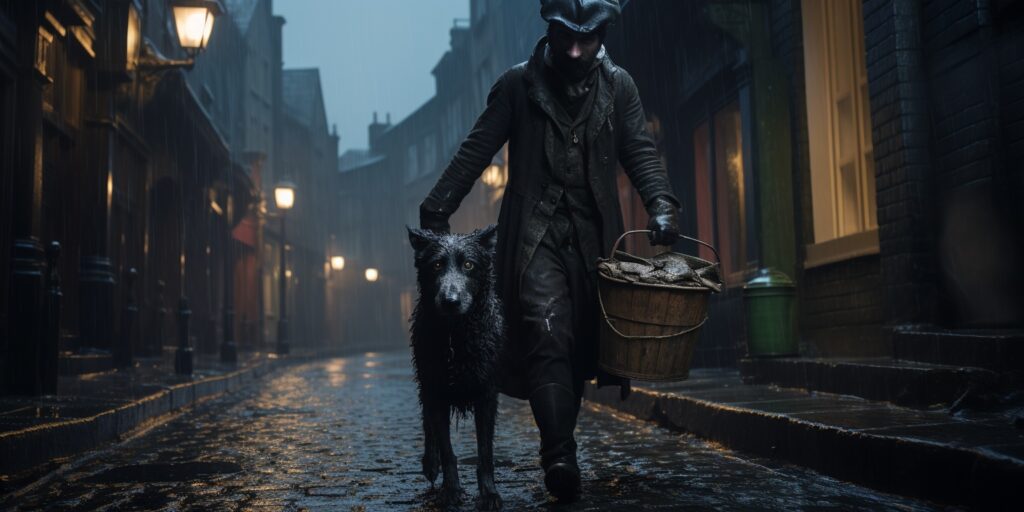What was a Victorian Pure Finder? Believe it or not, Pure Finders made a living by collecting dog poo and selling it to the tanning industry.

Dog ownership in the UK is at record levels, triggered partly by the COVID-19 pandemic and the new work-from-home culture. This trend has, unfortunately, led to a corresponding increase in the problem of dog-fouling of parks and pavements, but to Victorian Pure Finders, who collected dog excrement for a living, this would be regarded as a gold mine.
Pure Finders – Making a living from collecting dog poo
Affluent Victorian Londoners were equally fond of their four-legged friends as we are today but far less inclined to clean up after them.
Some areas were kept mess-free by street orderlies, but a much larger army, known as Pure Finders, would scour the streets, carrying a closed-lid bucket, looking for what most people would desperately try to avoid.
The authorities didn’t pay pure Finders to keep streets clean but by tanners, as dog faeces was used along with lime in purifying and softening leather.
Origins of the term Pure Finder
The word Pure Finder, someone who collects dog excrement for use in leather tanning, is likely a bastardisation of the word ‘puer’, which refers to animal dung used for leather tanning. The word puer is itself likely of French origin.
Victorian Londoners would refer to dog shit as pure, and therefore those who scavenged for dog mess, Pure Finders.
The detailed knowledge of the practices of Victorian Pure Finders is thanks to the unique work of Henry Mayhew.
Mayhew is regarded as one of the first citizen journalists, documenting in extraordinary detail the strangest jobs of Victorian Londoners who, without fixed employment, were forced into pursuits such as Pure Finding to survive.
According to Mayhew, there were around 200-300 Pure Finders in London around 1850, mostly women who struggled to make a living from common occupations, e.g. former mechanics and small trades.
How much could a Pure Finder earn?
Pure Finders could earn about 8d to 10d per bucket from the thirty tanyards in Bermondsey, and sometimes more depending on the quality, as it was a specific characteristic of the dog mess, its alkalinity, that was valuable to the end clients.
The ” dry limy sort ” fetches the highest price at some yards, as it is found to possess more of the alkaline, or purifying properties.
London Labour and London Poor, by Henry Mayhew
Pure Finding supported a standard of living not to be sniffed at – about £13 annually – very decent compared to London’s working classes, but considering how Mayhew described the practicalities of collecting the poop, the Pure Finders earned every penny.
Warning: you’re about to learn in great detail how the dog’s business was applied and collected; this might be the right time to put down your bacon sandwich.
How Pure Finding worked
The job of a Pure Finder was very straightforward. Walk the streets of London looking for dog turds, then collect them up.
In order to do this, a Pure Finder needed a bucket with a hinged lid that could obscure the contents and their odour, as well as discourage inevitable flies.
As much as the idea of collecting dog poo for money might seem revolting, it is just one of many ways to make money from shit, and besides, many people do it today for free when their family pooch produces it.
The big difference between modern dog owners and Victorian Pure Finders is that today it’s common practice to use disposable poo bags, whereas, according to Mayhew, many Pure Finders used their bare hands.
The Pure-Finder, is often found in the open streets, as dogs wander…..always carrying a handle basket, generally with a cover, to hide the contents, with a black leather glove; many of them dispense with the glove, as they say it is much easier to wash their hands than to keep the glove fit for use.
London Labour and London Poor, by Henry Mayhew
Given the preference for a certain type of doggie doing, the Pure Finders established tricks of the trade to achieve the right consistency by mixing it with loose mortar, which they could work free from brickwork.
Portrait of a Pure Finder
Though the subject of Pure Finder is one of those nuggets of information that might get a few likes on social media and laughs down the pub, behind every bucket of plop was a real person.
Within the detail recorded by Henry Mayhew is an interview with a 60-year-old woman, which provides a sorrowful portrait of the circumstances that led her to become a Pure Finder.
Her story is likely indicative of many other street folk reduced to scavenging for dog mess or the various strange trades particular to the Victorian era, such as sewer hunters, also documented by Mayhew.
The unnamed lady had been married twice, but neither husband survived by virtue of bad luck and drink. Despite having had eight children, all had died, leaving no one to support her and in permanent fear of the workhouse.
Despite her terrible situation, she described Pure Finding as offering a decent living in the early days (15 years prior), where tanyards would buy everything she could find. Inevitably, competition increased, driving down the living and forcing her to travel far and wide across London.
I’ve known several of our people, who have sat down in the street with their basket alongside them, and died…Almost everyone I’ve ever known engaged at Pure-finding were people who were better off once.
Interview with a Pure Finder, Henry Mayhew, London Labour and London’s Poor Volume 2
Why collecting dog poo was considered a decent job
While it is a natural reaction to feel pity for anyone reduced to scavenging dog turd for a living, Henry Mayhew regarded them as superior to many other street folk.
The pure-finders are in their habits and mode of proceeding nearly similar to the bone grubbers. Many are, however, better in circumstances, the men especially, as they earn more money. They are also, to a certain extent, a better educated class…..Many of them would not exchange their position for the best paid mechanic.
London Labour and London Poor, by Henry Mayhew
Who were Pure Finders selling dog shit to?
The number of Pure Finders wasn’t limited by the resistance to the nature of the work but by the monopoly they held. The most successful had arrangements with dog kennels, providing regular business, while others were forced to scour the streets, frustrated by the street orderlies whom they considered an ‘unwarrantable interference with the privileges of their class‘.
Given the relatively lucrative nature of the trade, a kind of supply chain of dog shit developed, enabling some Pure Finders to avoid getting their hands dirty, acting as a middle-man paying the least fortunate a fraction of what the tanners would pay to do the actual collection.
There is a perverse irony to the fact that dog shit was essential to the production of luxury leather items, so prized by Victorian London’s upper classes. The dog excreta was essential for the tanning process, being literally rubbed into the animal skin [wretch] to purify it before it was made into leather gloves, bookbinders and shoes.
As disgusting as the practice may seem, the tanning industry in Morocco still uses pigeon shit to soften and purify leather, a practice known as bating. Remember that the next time you consider buying a new handbag or pair of leather gloves.
FAQs
Victorian Pure Finders collected dog poo to sell to the tanning industry. The name derives from the process of leather purification that the alkaline content enabled.
Henry Mayhew estimated that in the 1850s, there were 200-300 Pure Finders, supplying around 30 tanyards, each employing several hundred men.
The word Pure Finder, someone who collects dog excrement for use in leather tanning, is likely a bastardisation of the word ‘puer’ which refers to animal dung used for leather tanning. The word puer is itself likely of French origin.
No Free Lunch
There is no such thing as a free lunch, but if you’re hungry to find out why, we’re here to help.
You can learn the meaning and origin of the no free lunch concept, as well as the broader philosophy behind the idea that nothing can ever be regarded as free.
We look at our relationship with money and truth, examining all of the supposed shortcuts, life hacks and get-rich-quick schemes.
